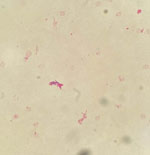Disclaimer: Early release articles are not considered as final versions. Any changes will be reflected in the online version in the month the article is officially released.
The species name for the bacterium Tsukamurella tyrosinosolvens was accepted in 1997 on the basis of biochemical attributes: tyrosina, from the amino acid tyrosine in cheese (tyros, Greek for cheese), which imparts a crystalline texture (Figure). The hydrolysis, or dissolving of tyrosine—thus, tyrosinosolvens—is a species characteristic.
The genus Tsukamurella consists of commensal bacteria with a propensity to cause opportunistic infections in immunocompromised patients, especially those with chronic lung disease. Tsukamurella bacteria are related to the genera Nocardia, Mycobacterium, Corynebacterium, and Gordonia. Gordonia aurantiaca was initially isolated in 1971 by renowned Japanese physician-microbiologist and Mycobacteria taxonomist Michio Tsukamura at Nagoya University in Nagoya, Japan. In 1988, he was honored with the genus name Tsukamurella.
Tsukamurella, retrospectively isolated by Edward A. Steinhaus in 1941 from the mycetoma and ovaries of the bedbug, was originally misidentified as Corynebacterium paurometabolum. Tsukamurella are weakly acid-fast; therefore, clinical manifestations can be confused with those of tuberculosis and create microbiological misidentification with Mycobacterium and Corynebacterium spp.
Tsukamurella infections are rare and usually associated with immune-suppressed patients, but severe infections have occurred in immunocompetent patients. Currently, of 17 known species, 12 cause human disease. Although Tsukamurella infections have been increasingly reported in Europe, Asia, America, and Africa, T. tyrosinosolvens has been the most common species observed.







